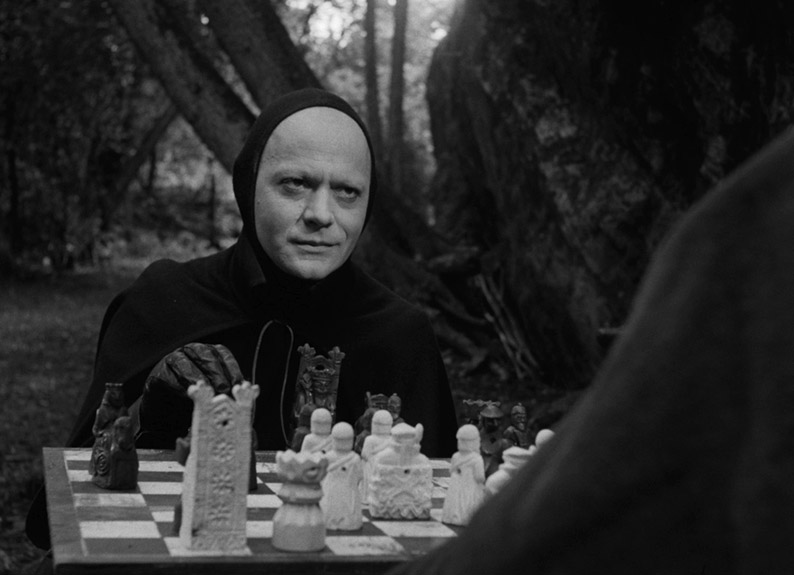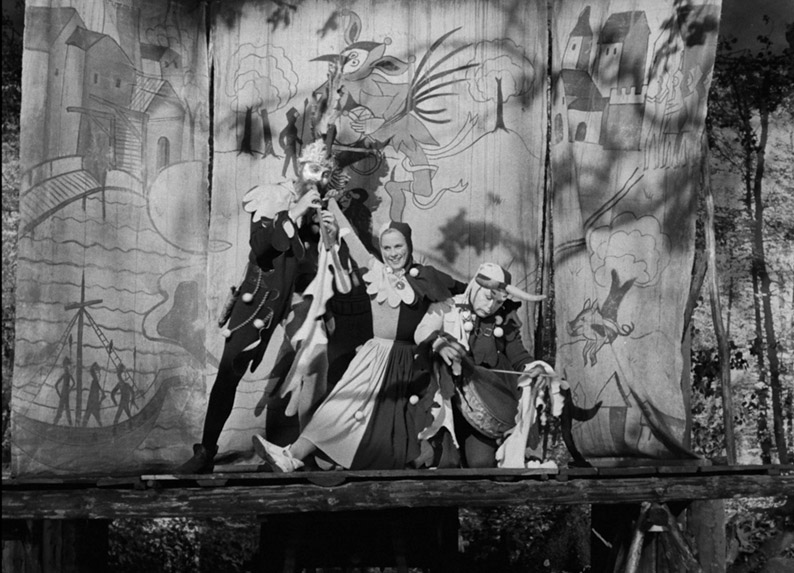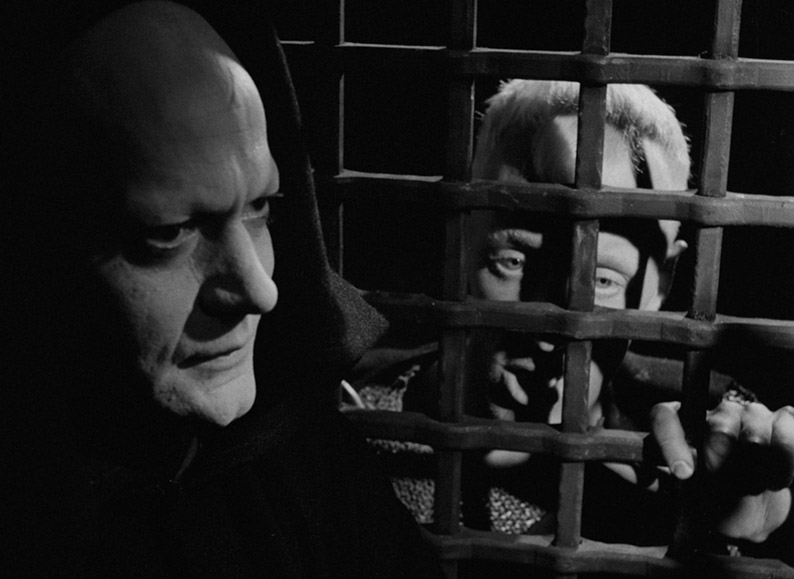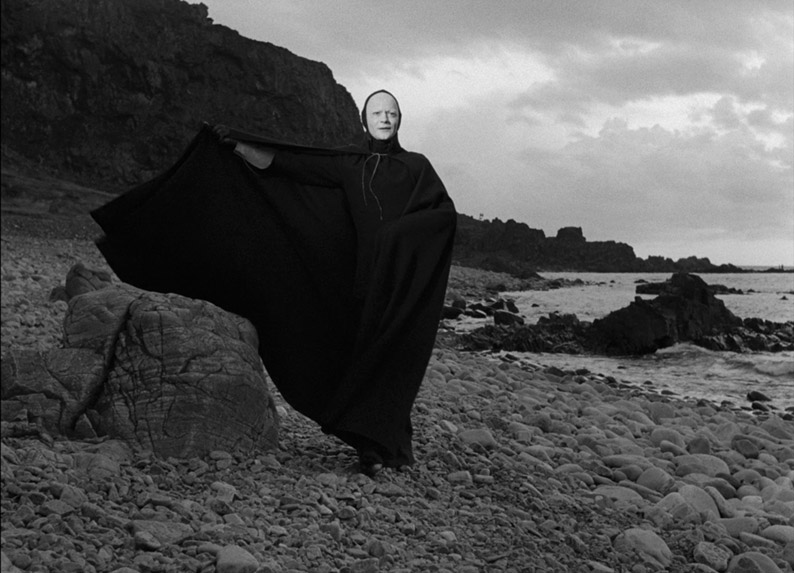|
At Outsider, we’ve been known to take an offbeat approach to our reviews on occasion, usually when we have a long-standing personal relationship with a film, or when one has been written about and analysed so much already that we’ve little new to bring to the debate except our own emotional response. Such is certainly the case with Ingmar Bergman’s 1957 The Seventh Seal [Det sjunde inseglet], possibly the most famous and instantly recognisable work by one of cinema’s most celebrated filmmakers. Many learned essays and a good few chapters in books have been written about it, and its influence on subsequent films and filmmakers is considerable. If you’ve read any of those previous writings on the film, some of which go into microscopic analytical detail, any observations I make about it are likely to trigger a strong sense of déjà-vu. Can you see where this might be headings?
Complicating matters further for this particular reviewer is that the film is being released on two formats by the BFI this month, initially on 4K UHD – a first but by no means last for the BFI – and then a week later on Blu-ray as part of its second Ingmar Bergman box set, which fellow reviewer Gary Couzens is currently hard at work on. As I am newly 4K UHD enabled and Gary is not, I agreed to make this my first UHD review, but am also keen to avoid undercutting Gary’s writing on the film by unknowingly covering the exact same territory in a review that, due to the staggered release dates, will inevitably be posted before his. I’m thus not going to take the deep dive into the film, its characters, its technique and its meaning as I would normally (and sorely like to) do, but instead take a more anecdotal approach and focus primarily on one aspect that rarely gets the coverage it deserves, fully aware that I may be seeing the film in a slightly different light to many Bergman scholars.

In common, I suspect, with many who grew up in a pre-internet age, I first became aware of The Seventh Seal through stills in film books, a favourite being that signature image of a knight playing chess with the black-robed and white-faced figure of Death. It all looked very solemn and meaningful, which fed into the serious-minded words that tended to accompany this image. This, in turn, played into the idea that Bergman films were tonally gloomy and heavy going, a notion I’d been sold on by fellow students at film school, none of whom had seen a single one of his films. It even gave birth to a gag that a friend of mine was fond of, that Bergman had stopped working with his favourite actor, Bibi Andersson, because she had the temerity to smile in one of his films. Hmm.
By the time I left film school, my appreciation of what cinema had to offer had expanded dramatically from my previous far narrower viewing habits. Summer and winter breaks spent working a short distance from London’s National Film Theatre (now BFI Southbank) gave me the chance to see three or four films a week after work and catch anything of interest that was showing before heading back to home base. I’d also become a devotee of the Time Out cinema listings (then City Limits cinema listings when an industrial dispute saw the most prominent reviewers jump ship), which helped to steer me towards whatever independent cinema was screening something I’d not seen and that was of potential interest. During this period I discovered the works of Kurosawa Akira, Andrei Tarkovsky, Luis Buñuel, Federico Fellini, Vittorio De Sica, François Truffaut and a good many others. Yet the ghost of those film school discussions clung to me like a stalker, and it took me some time to finally give Ingmar Bergman a try. And wouldn’t you know it, the first film of his I saw was The Seventh Seal, though I have a sneaking suspicion that, having made camerawork my film school specialisation, I was drawn to it more by the reputation of its visuals than whatever its content might have to offer. As it unfolded, however, I couldn’t believe this was the film we had all had such glum preconceptions of at film school. The reason? Well what caught me out the most – and I know this will irk some Bergman purists – was that a surprising amount of it was fun. Yes, it deals with serious themes and compellingly philosophises on human mortality, the nature and existence of God and the dangers of religious fanaticism, and there are sequences it that are genuinely haunting and disturbing, but nothing I had read about the film talked about its lighter elements and its sly sense of humour.
A quick plot summary certainly provides no clues. A Swedish knight – the brilliantly named Antonius Block (Max von Sydow) – returns to his plague-ravaged homeland with his squire Jöns (Gunnar Björnstrand) after several years fighting in the Crusades. While Antonius is resting on a beach before beginning his journey home, the figure of Death (Bengt Ekerot) arrives to take him. The wily Antonius responds by challenging Death to a game of chess, with the proviso that he be permitted to continue his journey whilst the game is being played, and to be freed to live if he should somehow win. As Antonius and Jöns embark on their journey home, the character pool widens to include those that the two men encounter en route. These include travelling players Jof (Nils Poppe), his wife Mia (a radiant Bibi Andersson, who smiles a lot here) and the disgruntled Jonas (Erik Strandmark), who absconds with Lisa (Inga Landgré), the amorous wife of an angry blacksmith named Plog (Åke Fridell). Of particular interest to the theologically curious Antonius, however, is an unnamed girl (Maud Hansson), who has been accused of consorting with the Devil and is being transported by soldiers to a place of execution. Anyone laughing yet?

If you don’t count Death’s early comment about the appropriateness of him playing with the black pieces in the chess game, the first sign that this is not going to be the po-faced drama I was once expecting comes when Antonius tells the lounging Jöns that it’s time to move on. Instead of respectfully getting to his feet, Jöns responds with a contemptuous expression and noise that I’m not going to attempt to describe here, beyond suggesting it’s a wide-mouthed and mocking variant of “Pah!” Indeed, it’s Jöns who is behind a good many of the film’s lighter moments, as he questions church painter Albertus Pictor (Gunnar Olsson) about his fondness for scary imagery, feeds lines to Plog to assist him in an argument with Jonas, and predicts every stage of Lisa’s reconciliation plea. But Jöns is not a comical sidekick in the style of Roy Kinnear’s Planchet in Richard Lester’s The Three Muskeeters, but someone that Antonius clearly respects and treats almost as an equal, a hardened battle veteran who intervenes to stop a rape by convincingly threatening the attacker (Bertil Anderberg), then demands that the girl he has rescued (Gunnel Lindblom) become his housekeeper. There’s a winningly playful tone to many scenes, but for me the most blackly comic moment is delivered – unexpectedly, but somehow appropriately – by Death, when a man fakes his suicide to trick an angry pursuer and climbs a tree to avoid falling victim to wild animals at night, but quickly discovers that it offers no hiding place from the Grim Reaper, who has had the good foresight to arrive at their fateful meeting with a tree-felling saw.
I could continue at some length and get deep into the film’s themes, its consistently excellent performances, its fascinating philosophical ruminations on mortality, faith and religious hysteria, its sublime character interplay, and so much more, but as I said above, I’m trying to avoid stepping on the toes of a review I have not yet seen. The film’s influence can be felt on a surprisingly diverse range of works, though most blatantly in comedies, from Woody Allen’s Love and Death (whose finale directly parodies the ending here) to Bill and Ted’s Bogus Journey, whose Grim Reaper and the games he plays with the titular characters (“You have sunk my battleship!”) as they bargain for their lives are drawn unmistakably from this film. As for Bergman regular Gunnar Fisher’s consistently stunning monochrome cinematography, what can I say that hasn’t already been said many times over? It really is extraordinary, in its use of light and dark, in compositions that contribute to the storytelling but are also laced with secondary meaning, and in its potent evocation of an era that we know about primarily through the written word.
I now have a long-standing relationship with this film, but given its age and the ever-evolving nature of cinema, it’s interesting to speculate on how might it play today to younger viewers, those more familiar with its influence than the source material (there’s an interesting story in the commentary about this very notion). Time, I guess, to return to the anecdotal. A few years ago, I was teaching on a media course on which one initially unpromising young student was starting to demonstrate considerable talent. His breakthrough project saw him using photography and editing techniques to capture the effects of different recreational drugs on a single user. Then, having been blown away by the early Dogme 95 films, he entered a 48 hour film contest (in which you are given a set of parameters and elements to include and just two days to make a film from them) and delivered a remarkably assured but highly confrontational, Dogme-influenced tale of spiteful revenge (it came second). He even reshaped footage from his holiday in New York into an avant-garde exploration of American culture that metamorphosed into a trippy critique of the death penalty. Clearly, formal filmmaking had no interest for this imaginative and increasingly skilled young filmmaker. Then, one day he asked me to look at a rough cut of a sequence from his latest work, and I was caught on the hop. Expecting another broken mirror assault on the senses, I was instead presented with some genuinely striking monochrome video footage of the nearby coastal region, a series of handsomely framed static shots in which the rocks, the cliffs, the shoreline and the actors were arranged in frame with a real eye for composition. What, I asked him, had brought about this startling change in his until-then explosively experimental style? The answer was simple. He’d seen The Seventh Seal and had been left stunned by the film and its visual style. For him, it opened a door to a different approach to visual storytelling, one he wanted to draw from and develop in his own way, something he was clearly on the road to doing. I wish I could tell you that this put him on the path to a notable filmmaking career, but the last I heard he had abandoned video production and moved to South Africa with a woman that he met when she was holidaying in his home town. Ah, what might have been…

So having danced around many of the specifics, how does The Seventh Seal play for me after a gap of several years? It’s wonderful. No, scratch that, it’s still wonderful. There are great films that we admire for their artistry and others we enjoy for their entertainment value, but some of the very greatest of all see the two working in perfect harmony, and The Seventh Seal is just such a work. Despite sequences of serious contemplation and an underlying sense of horror – something that’s covered in more detail in the commentary on this disc – it’s never as heavy as most synopses tend to make it sound, and it never hammers home those themes that it explores in such unwaveringly riveting fashion. Its drama is peppered with humanity and humour, its story unfolds at a brisk but never overly hurried pace, its cast is a joy (man, that Max von Sydow was a handsome devil in his younger days), it looks divine, and its dialogue, although translated for us non-Swedish speakers, is both intelligent and witty. I love this film, and time has failed to dull this particular romance one iota.
| sound and vision – a preamble |
|
Before I get going here I have to talk about a couple of things. Now while this is not the first 4K UHD review on the site (that was clydefro’s coverage of the US UHD of Knives Out), it’s absolutely my first, and I’m coming to the format as a relative newbie. I spent money I’d saved for a holiday on a 4K TV in the early days of the Covid lockdown and was given a UHD player my generous friend and fellow reviewer, Camus. The problem was, this setup was incompatible with my home cinema system’s DTS receiver, which interpreted every audio signal sent to it – from Linear PCM 1.0 mono to 7.2 Dolby Atmos – as PCM 2.0 stereo. Atmos-compatible 4K receivers are expensive, but I managed to find a Sony unit that was reasonably priced, but the few suppliers who had it advertised for sale were having serious trouble getting hold of any. A helpful chat with a fellow at Richer Sounds ended with me reserving one for whenever they managed to secure a new supply. I was warned it probably wouldn’t be soon. It took a few months, but a couple of weeks ago it finally arrived, and not only does it handle all the UHD sound formats splendidly, it’s proved to be a notable improvement on my previous receiver in every respect.
It’s also worth mentioning that I am, at present, unable to do screen grabs from UHD discs, primarily because I’ve yet to find a program that will allow me to read a UHD disc on my iMac (if anyone knows of one, please get in touch). Thus, for the foreseeable future, any stills used to illustrate reviews of UHD releases will either be supplied by the distributor or grabbed from the equivalent Blu-ray release. To be honest, at the size we post our frame grabs and with few computer or even tablet or phone screens currently HDR-enabled, I’m willing to bet that the differences would be nigh-on impossible to spot, but I’m coming clean on this now to save accusations of misrepresentation later. The still images from The Seventh Seal featured here have kindly been provided by Gary from the Blu-ray edition in the BFI’s Ingmar Bergman box set. All clear?
But I digress. The point I’m trying to make is that I deliberately held off from watching any UHD discs until I could listen to their soundtracks as they were meant to be heard, and while I have looked at sequences from Arrow’s UHDs of Crash and Tremors, The Seventh Seal is the first film I’ve watched on the format in its entirety. I am thus, at this stage, not in a position to authoritatively comment on how this transfer stacks up against those on other UHD discs of films from this period, and do not have the Blu-ray of The Seventh Seal to compare how the transfer on that disc compares to the UHD. So with that in mind, let’s get on to how the film looks and sounds to a UHD newcomer.
For its first UHD release, the BFI made a really smart choice in opting for a film as visually striking as The Seventh Seal, with both the 4K transfer here and the 1080p one on the Blu-ray disc sourced from a 4K restoration by the Swedish Film Institute from an original 35mm negative. The results are genuinely sumptuous, despite some very slight variation in the sharpness visible in some marginally less crisply defined detail on elements like grass or other textures in some of the wider shots. I should note that I’m saying that as someone who studied the image quality by standing close to the screen with my reading glasses on, where I was able to marvel at the sharpness of the image at its best, and it’s at its best a lot. Like I said, I’m not presently able to compare this 4K transfer with the Blu-ray of the same, but I’m willing to bet that the most noticeable difference between the two discs will lie in this disc’s use of HDR. For those even newer to the format that me, HDR stands for High Dynamic Range, which reveals more visible detail in the shadows and highlights, and boasts a wider contrast gamut that should, theoretically, result in a richer and more film-like image, albeit with the advantage of black levels that actually display as black. That’s certainly the case here, as I encountered shot after shot that I could be fooled into believing was filmed only recently, so gorgeous is the tonal range and so well defined the detail. This is especially evident on clothing, anything made of wood (grain and bark textures love high definition monochrome), facial close-ups and wider crowd shots. As you would expect, the image is largely spotless, is locked firmly in frame, and displays a fine and most natural-looking film grain. A few small instances of hairs caught in the camera gate at the shooting stage do remain, which are doubtless on the original negative and have not been digitally removed. Overall, this is a lovely job and the best I’ve ever seen this beautifully lit and composed film look.

The Linear PCM 2.0 mono soundtrack was also restored alongside the picture, and while there are some unsurprising restrictions in the dynamic range, the dialogue and effects are consistently clear and do not display the sort of hissy trebles that you’ll find on some films of the period. I didn’t pick up on any signs of damage or wear, and the optional English subtitles that kick in by default are always clearly presented and pleasingly Anglicised.
Audio Commentary
Gary may have more to say about this welcome commentary from critic, Diablique magazine editor-in-chief and Bergman enthusiast, Kat Ellinger, so I’ll confine myself to confirming that it makes for fascinating listening, containing as it does a detailed analysis of the film and how the director’s personality is reflected in its characters and themes. The evidence she presents for seeing this as the godfather of folk horror movies is of particular interest, and I was perversely delighted to discover that she first discovered Bergman through The Seventh Seal because she was such a fan of Bill and Ted’s Bogus Journey. Bodacious!
Trailer (2:44)
The original Swedish trailer, which lays out the plot in compact but somewhat literal terms, right up to the story’s end. Don’t watch before seeing the film for the first time.
Behind the Scenes Footage (14:50)
What a rarity and joy it is to see home movie footage of the shoot on a film of this vintage, much of which is usefully contextualised here by respected film scholar Ian Christie. He scores a real bull-eye when he describes the character of Jöns as a Baldrick-like figure – I’m genuinely kicking myself for not thinking of that one.
Also included with the commercial release is Karin’s Face (1984, 15 mins), a short film by Bergman based on pictures from his personal photo album, particularly those of his mother, Karin, but this is only on the included Blu-ray disc, and I’ve yet to get my hands on that fellow.
Booklet
The bulk of this 14-page booklet is devoted to a seductive essay on the film by critic Jessica Kiang, who also cites the two comedy films I mentioned above as prime examples of The Seventh Seal’s considerable influence. Also included are credits for this film and details of all of the on-disc special features.
I’m in an odd situation here. Just occasionally, we get the chance to write about favourite films and usually do so at some length, and while The Seventh Seal is absolutely a prime candidate for just such a review, the desire to dive headlong into it has to be balanced with a currently heavy workflow in my day job, the awareness that almost anything I say about it will have been said by many others before, and the fact that my fellow reviewer is also covering the film as part of Bergman box set. It’s for this reason that I’ve approached it from a specific viewpoint, one I’m starting to think I’m almost alone in holding. The overriding perception of the film still seems to be that it’s a dark and serious drama dealing with weighty issues, and that there are only occasional moments of humour, but I’ve never seen it that way. For me, this is one of Bergman’s most entertaining and approachable films, and while the serious turns it takes are haunting and thought-provoking, it’s never depressing. As Kat Ellinger suggests in her commentary, it’s also – a little ironically – an unexpectedly life-affirming work, one in which Death appears to ultimately clear the way for a new and more optimistic future.
As I suggested above, this is a sublime choice for the BFI’s first UHD release, and it looks genuinely lovely here. The UHD package also comes with a Blu-ray disc of the same, so if you’re only looking to get this one film rather than the Bergman collection and haven’t yet made the jump to 4K, this still comes highly recommended, as the Blu-ray is sourced from the same restoration, and if you do upgrade later, you’ll have the UHD version ready and waiting. |